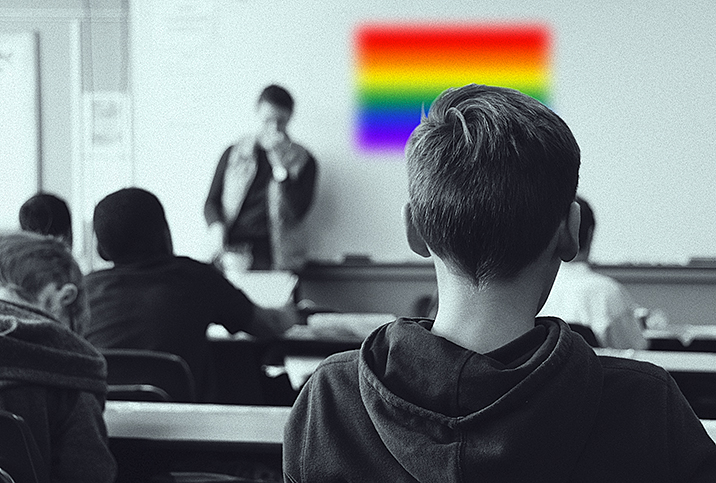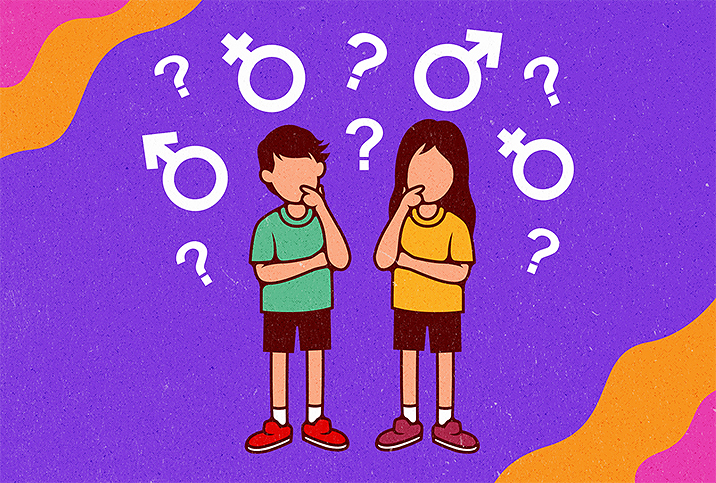The Ingredients for Inclusive Sexual Education

If you feel out of touch with the archaic Puritan roots of the United States, take a look at the sexual education taught in our schools.
As of now, only nine states mandate that students learn about consent and five states have no sex education mandates in place at all. Another nine states explicitly require instruction that discriminates against LGBTQ people, according to SIECUS, known formally as the Sexuality Information and Education Council of the United States.
However, we're not here to lament this void. Rather, we're here to reimagine what sex ed could be.
I was raised in one of the nine states that require children to be versed in consent, but even my relatively liberal sex education still included what I would call fearmongering as part of its curriculum. The bulk of what we were taught came from a preventive angle, that is, avoiding sexually transmitted diseases (STDs), preventing pregnancy, and recognizing and surviving abusive situations and relationships.
But let's consider what sexual education might look like if it began from a place of positivity and strength.
Begin with bodily autonomy
Sex educator Chris Wellman, of Denver, laid out his ideal starting point for a sex ed curriculum.
"Bodily autonomy. I don't believe we should teach just the fact that an individual has bodily [autonomy], but how to use and exercise it," he explained. "How to ask for consent in any situation, how to comfortably say 'no' and how to receive a 'no' are all pillars of practically teaching bodily autonomy. And I would love to see them being taught more widely, especially from a young age."
Bodily autonomy is a notion easily applied to the youngest age groups, whether it's engaging in familial affection you want to engage in or making sure that other children are happy with the games being played.
Giving and receiving no's is a little-nurtured but widely applicable life skill. A child or teenager can learn that their "no" is powerful, valid and acceptable. Imagine what a confidence boost it would be to not feel like your "no" is someone else's burden. In turn, an earnest "no" from another person only makes a "yes" that much more gratifying.
The notion that sex education could be a foundation for our understanding of all parts of life, rather than an uncomfortable chore to withstand, would help individuals of any age gain a richer sense of self. Sex ed can be introduced into the fundamentals of a child's education at a young age without seeming inappropriate.
"Sex ed can start as early as any education," said Natalie Higgins, a sex educator based in Denver. "Parents can start correctly identifying body parts on their infants before they even talk, just like they tell them where their toes or their eyes are. Formally, sexual education can start in pre-K or kindergarten with topics like personal boundaries and healthy friendships."
Helping individuals learn about themselves
As opposed to introducing children to their genitals by using euphemisms that connote secrecy or shame—no one's ever taught a cute nickname for their elbow—naming the body part properly gives a child the language to address their experience. Nicknames are fine but they can augment the naming of a person or thing.
Higgins emphasized individuality in sexual education.
"The most useful curriculum is one that helps individuals identify their own personal values surrounding sex and sexuality, and teaches them how to make educated and informed decisions that align with those values," she said.
It's difficult to overstate how revolutionary this perspective would be in shaping young minds. Highlighting personal values in sexuality, which is a continuation of bodily autonomy, rejects the idea that all values are universal or definitive. Considering the American emphasis on individuality, it's actually very un-American for young people to be sexually informed by a singular set of values.
As opposed to cultural norms demonizing and exoticizing anything other than penetrative sex for reproduction, an individual could explore what they value in their own sex life, based on strategies of connection, honesty and open communication.
Dispelling shame and stigma
Instilling joy is the paragon, but it's also vital to eradicate shame as a necessary step on the way toward adequate sex ed. The clearest area for eradicating shame is in our understanding of sexually transmitted infections (STIs). Higgins proposed a paradigm shift in how common diseases such as herpes and gonorrhea could be introduced to children.
"I think the most important step in destigmatizing STIs would be to give a realistic picture of what living with an STI looks like," she explained. "The current method is to scare people into thinking STIs are horrific, when really it's just like any other infection."
Presenting STIs as something to be avoided without demonizing people who contract them would represent a huge shift. For instance, would you rather call out sick and tell your boss you have an infected wound or a case of gonorrhea? We're taught STDs are somehow different from the flu or any other manageable condition requiring treatment. And that's just false.
In our current education system, a child is introduced to their body only when puberty's changes occur—assuming that happens at the same time across an entire class. This information doesn't require a transformation to be relevant and valuable. Our genitals are another body part, like arms or legs, for us to understand and use responsibly.
The biggest difference is that arms and legs don't occasionally make life decisions for us.


















